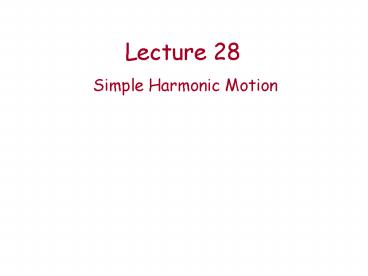Simple Harmonic Motion - PowerPoint PPT Presentation
1 / 21
Title:
Simple Harmonic Motion
Description:
When a 1D system is released near a stable equilibrium ... ACT: Grandpa's clock. Grandpa decides to move to the Moon, and he naturally takes his old pendulum ... – PowerPoint PPT presentation
Number of Views:27
Avg rating:3.0/5.0
Title: Simple Harmonic Motion
1
Lecture 28
- Simple Harmonic Motion
2
Periodic motion
A motion is called periodic when the system comes
back to the same situation every time interval T.
Examples Uniform circular motion Earth around
the Sun Toy train in a circuit
3
Oscillations about an equilibrium position
When a 1D system is released near a stable
equilibrium point, the motion is periodic
oscillations between two turn-around points x1
and x2.
U
x
SE
4
Simple Harmonic Motion (SHM)
SHM is the oscillatory motion due to a restoring
force that is proportional to the displacement
from the equilibrium position F ? x
equivalent to
or when the potential energy is a quadratic
function of the displacement from the equilibrium
position U ? x2 (a parabola)
5
Example of SHM Spring that obeys Hookes law
Oscillations about x 0
U
E
x
x0
x0
6
Most oscillatory systems can be approximated by
SHM when the oscillations are small enough
U
x
x1
x2
Technically Taylors expansion of U(x) up to the
quadratic term
7
The SHM equation
8
SHM equation
General solution
9
x
t
x 0 Maxv A? a 0
10
ACT Amplitude
- Two identical masses hang from two identical
springs. In case 1, the mass is pulled down 2 cm
and released. In case 2, the mass is pulled down
4 cm and released. How do the periods of their
motions compare?
A. T1 lt T2 B. T1 T2 C. T1 gt T2
11
Example SHM spring
A 3-kg block is attached to the end of a spring
with k 1000 N/m. The spring is compressed 25 cm
as shown and released at t 0. What is the
velocity of the mass 10 s later? (Use the given
x-axis).
- 4.57 m/s
- -4.57 m/s
- 1.73 m/s
- -1.73 m/s
- 0.00 m/s
12
A 3-kg block is attached to the end of a spring
with k 1000 N/m. The spring is compressed 25 cm
and released at t 0. What is the velocity of
the mass 10 s later?
Answer C
13
ACT Initial conditions
Lets consider the same example with the
horizontal spring, but now we set the clock to
zero when the block is passing through the
equilibrium position with velocity in the
positive-x direction. If x A cos(?t f),
determine the phase f.
A. f 0 B. f p/2 C. f -p/2
x A cos(?tf) v -A? sin(?tf)
14
Energy in SHM
The SHM driving force is conservative, so
mechanical energy is always conserved. The energy
oscillates back and forth between the kinetic and
potential forms.
15
ACT Energy oscillations
- A mass m 5 kg oscillates at the end of a
spring of constant k 2000 N/m. At t 0, its
acceleration is maximum. How long will it take
before the potential energy reaches its next
maximum?
A. 0.31 s B. 0.16 s C. 0.08 s
16
At t 0 Max a ? Max x ? Max U
U
To get to the next peak in U, it takes half a
period
t
17
The simple pendulum
A mass m is suspended at the end of a massless
string of length L. Find the frequency of the
oscillations for small displacements.
L
?
18
P
L
?
19
ACT Grandpas clock
Grandpa decides to move to the Moon, and he
naturally takes his old pendulum clock with him.
But gravity on the Moon is approximately g/6...
As a result, his clock is
- Too fast
- B. Too slow
- C. Too fast until noon, too slow after noon.
20
(No Transcript)
21
The phase shift.
v
A?
A
-A
-A?
x
T/4
T/4
t
t































